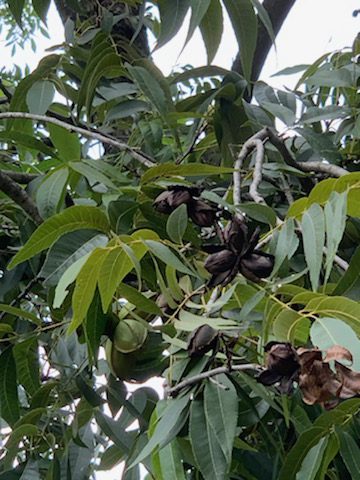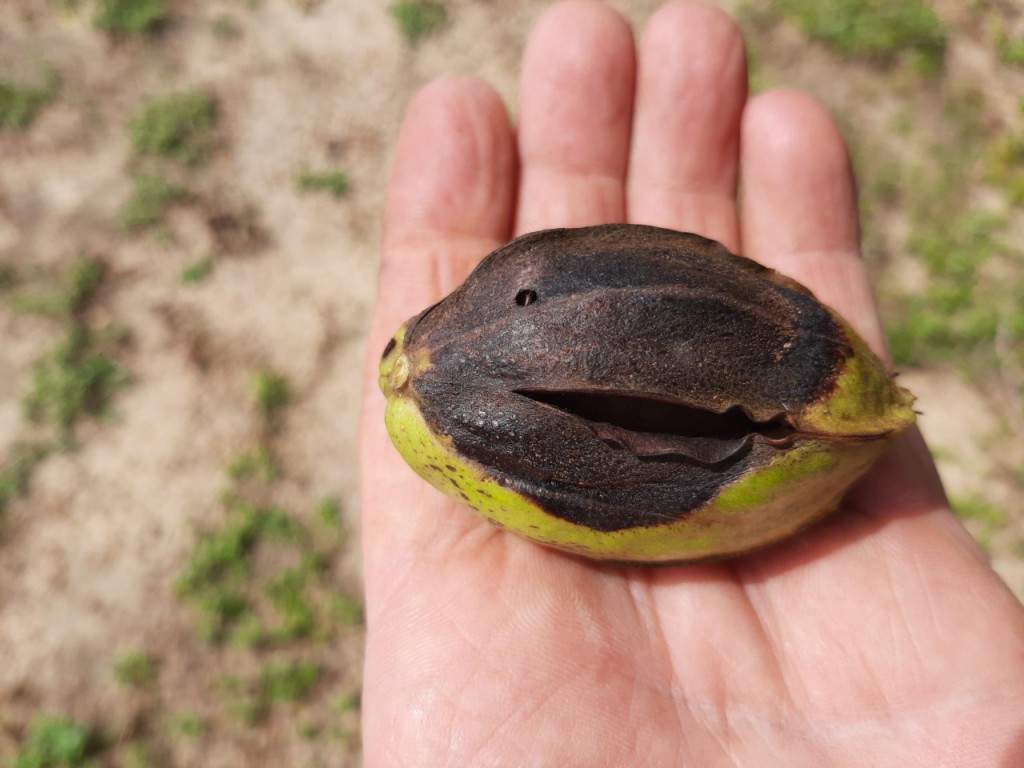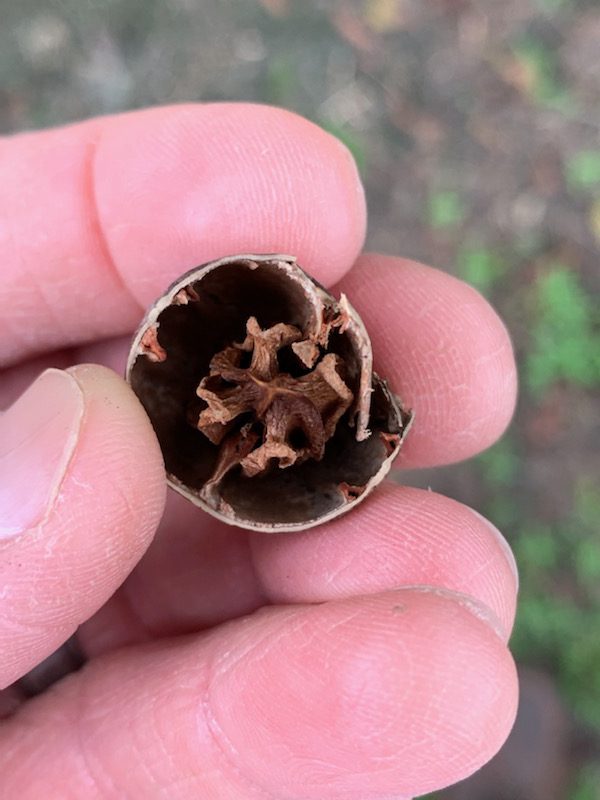
Black shucks in Appling County – Photo by Shane Curry. Appling County Ag Agent 
Black shuck splitting at suture in Ware County – Photo by Scout Carter, Ware County Ag Agent
Growers are starting to see symptoms of shuck decline in the orchard. Symptoms range from shucks turning all the way black to the tips green shucks turning black and peeling back at the suture. In some cases, kernels are black and in other cases, there is no kernel. The degree of declining shucks is different from tree to tree.
Beginning last week, many of these samples were brought to the diagnostic lab. Growers had an initial concern of Phytopthora, but all tests for the pathogen have been negative. We have not seen Phytopthora in recent years. When it has been confirmed, it has not been observed much below Macon.
However, anthracnose, is one possible cause. It is caused by the fungus Glomerella cingulate. This has been identified on most shuck samples. It needs to be clear that Anthracnose as well as another fungal pathogen, Phomopsis, are usually opportunistic or secondary pathogens associated with shuck decline. Glomerella in particular will be found on shuck tissue that receives any type of damage. For instance, it can be seen sporulating on shuck in the photo below where the primary cause of the lesion was shuck worm, as evidenced by the tunneling inside as well as the emergence hole in the tissue.

Anthracnose sporulation on shuck worm injured nut – Photo by T. Brenneman 
Anthracnose sporulation – Photo by J. Brock 
Anthracnose on Wichita – Photo by T. Brenneman
Something to note is throughout this season almost all leaf scorch samples brought to the lab showed anthracnose. On leaves, anthracnose looks like scorch. Growers notice these symptoms in July and August. Anthracnose is actually one of the things that causes ‘scorch.’ For shucks, the typical symptoms of anthracnose appear as dark and sunken lesions on shucks often starting at the base of the nut (photo above). Wichita is one cultivar susceptible to anthracnose on the shucks, and lesions often are initiated where multiple nuts on a cluster physically grow into each other causing a wound. These lesions often occur very late enough in the season.
To emphasize, the primary issue here is shuck decline. Shuck decline is primarily a stress-related problem and on Stuart and most prolific cultivars, it will always be worse on trees with a heavy crop load. Especially on large, old trees with an overloaded crop it can be hard to get enough water even with the best irrigation. The nuts without kernel are related to this and are a natural fruit abortion because the tree cannot handle the crop load they are bearing. Shucks will turn dark on these nuts. Additionally, the tree will abort more nuts later as the water demand increases through kernel filling. These aborted nuts will simply stop development and the shucks will turn dark. This is why we see varying stages of kernel development on these trees. The fungal organisms causing anthracnose will then jump on the declining shucks but they are not the primary cause. The primary cause is stress generated usually by crop load.

Pops in Appling County – Photo by S. Curry 
Dark kernel in Ware County – Photo by S. Carter
What should growers do now?
Continuing to irrigate is the best thing you can do to minimize the progression of this problem going forward. This will be critical if September and October turn dry. See blog posts from previous years here: https://site.extension.uga.edu/pecan/2016/11/will-stuart-nuts-open/ and here: https://site.extension.uga.edu/pecan/2019/09/late-season-drought-when-should-you-turn-off-the-irrigation/ to see this is a common problem under these conditions.
This is also a sign that there is potential for some vivipary and embryo rot if adequate irrigation is not continued up to harvest if soil conditions become dry.
How much will this hurt the crop?
It depends on when the decline starts during during development. If the shuck has already split open, likely they can still shake the nut from the tree and it be fine. However, much of this dark color on the shucks beginning before they open may hurt yield and quality. Another major factor is how dry fall conditions are prior to completion of shuck split. Again, the primary cause is crop stress.
Authors: Jason Brock, Dr. Tim Brenneman, Andrew Sawyer, Dr. Lenny Wells
